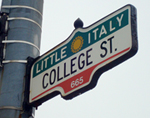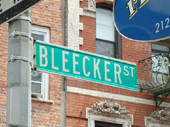Mulberry's doesn't sell Negronis anymore. It used to. Back in its heyday, in the 1940s and 1950s when it was called Joe's, this particular brand of Italian beer was all this bar would serve to a good 10,000 Italian or Italian-American citizens living in Little Italy. Now that the last census numbers them around 2000, things have changed.
Little Italy may have been lionized by Hollywood in dozens of mafia movies. But New Yorkers know well that it's been decades since the neighborhood ceased to be Italian.

Once upon a time, bars like the Mulberry's were a meeting point for the neighborhood's inhabitants and, in a not-so roundabout way, as covers for speakeasies and gambling gigs (gambling was forbidden in New York until the 1970s). Now only the memories remain -- both those of its residents and the legends their neighbors have passed on from one generation to another.
The merely four blocks that could be considered Italian nowadays largely live thanks to appearances -- it is practically impossible to find an Italian in restaurants like La Mela or Il Palazzo. Even in establishments like the noted Ferrara Caffé or the Caffé Roma, workers are Spanish.

It all began in the 1960s, when a Chinese family crossed Canal Street (which back then was known as "the frontier") from nearby Chinatown to open up a tux rental shop in Elisabeth Street.
After that, if you ask its residents, they will say that Little Italy's transformation has been fast and furious. The Chinese began to acquire Little Italy buildings. The Italian Americans, still searching for the American Dreams, moved on to Brooklyn and Queens (ever wonder why Friends' Joey Tribbiani was written as a character from Queens?). Only the skeleton of Little Italy remains, and a single street, Bleecker, which Little Italians never considered as their own.

Thus, the mainly Italian mafia presence weakened. And then, of course, Rudolph Giuliani came in and made the neighborhood safer.
And that paved the way for tourists. Eager to see the streets where Robert DeNiro and Harvey Keitel learned the ropes of gangsterhood in movies like Martin Scorsese's Mean Streets, tourists still flock to savor the story of a neighborhood they assumed was more celluloid than concrete.
But even if their presence was fated to alter the neighborhood, it had already changed. There were no longer a few families running the neighborhood in a conservative way. As the years progressed into the 1970s and 1980s, there was no way to make an Italian son marry an Italian girl. People would fall for black women, white women, Chinese women and so on. People became more sophisticated and the neighborhood became yet smaller.
Sure, the inside of the Mulberry's is still as gangster-movie-like as it gets -- nicotine-stained walls, Italian-flavored mosaic floors, fading photos of Frank Sinatra and other famous Italian-Americans (you can see Madonna in it as well -- she shot one of her first music videos there). But then you get to its twentysomething year-old waiter, Larry Gagliardotto, and see a big, Italian-looking man with the almond-shaped eyes of a Chinese citizen and realize progress has taken over.
Every day, Little Italy becomes Littler Italy.